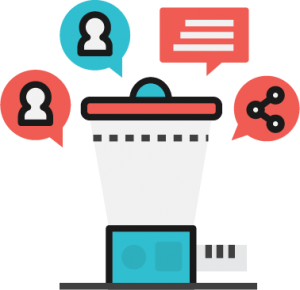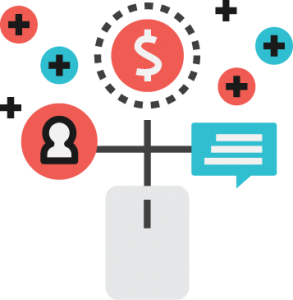
- Types of Research and Why You Need Research
- How to Analyze your Research to Approach Content Correctly
Content that Drives Brands and Leads
- Using your Blog and Social Platforms for Brand Loyalty and Lead Generation
- Gated Content for Lead Generation
- Driving Lead Generation through Assessments and Surveys
Measuring Digital Marketing Results
- Using Automation Tools to Measure Digital Marketing Effectiveness
- Digital Marketing Analytics that Drive Strategy
What is digital marketing?
 Digital marketing has evolved as a way to attract — and track — online buyers by delivering specific content for their problems or interests. To be successful, you need to understand:
Digital marketing has evolved as a way to attract — and track — online buyers by delivering specific content for their problems or interests. To be successful, you need to understand:
- How potential clients are searching for your services;
- How to compete for strong online search results;
- What types of content will attract the most interest;
- How you can get qualified visitors to take action, and;
- How to nurture great leads toward actual new firm business.
Let’s be clear. More than 90 percent of visitors to your site are searching for a solution, but need convincing to contact your firm. Digital marketing content and SEO are critical to keep them interested and keep your firm top of mind.
Website
 Firms that are operating on outdated web platforms or with old design templates are missing some critical opportunities. When referred to a new firm, many prospects go first to the website. When seeking a new job, candidates often head to the website to learn about the culture. An old website can do more harm to your firm’s image than ever before.
Firms that are operating on outdated web platforms or with old design templates are missing some critical opportunities. When referred to a new firm, many prospects go first to the website. When seeking a new job, candidates often head to the website to learn about the culture. An old website can do more harm to your firm’s image than ever before.
If your website looks staid, boring, and “template-like,” that one chance to make a great first impression is over. The key to great websites is to think through who will use it, how they will use it and how to communicate your services and unique culture and the value you bring.
Before you write one word or design one page, consider what you want your website to do based on how the audience will use it. Do you want it to speak primarily to prospects or recruits? Is it an information service for clients? Do you want to get leads from your website?
Making it pretty is not enough. Be clear about your target market and what you want to communicate to them. When we work with clients on a website, we like to establish some key messages about the firm that can act as a guide for content. This sets a tone and ensures that the firm’s website isn’t cookie cutter.
Writing copy for websites is different than writing for a proposal or marketing flier. Use a professional writer who has experience with websites, as well as one who understands your industry. Have that person write the sections that matter most: your Home Page, Services, About Us and key leader and staff bios. If you are having trouble recruiting, hire a writer to add some snap to your career pages. If your firm is moving into a specialized niche, work with a writer to develop key messages and web content that helps your firm rise above your competitors.
Search Engine Optimization (SEO)
 Getting on top of search results organically is a process that requires strategy and patience. There are many ways to build an SEO friendly website to provide better rankings on Google and other search engines.
Getting on top of search results organically is a process that requires strategy and patience. There are many ways to build an SEO friendly website to provide better rankings on Google and other search engines.
- Choose keywords that are unique to your business. Brainstorm these words and phrases in your website committee and make sure they are used frequently in your site content. Consider working with an SEO specialist to find keywords and phrases to get additional possibilities and performance forecasts.
- Try to establish external links to your website. Have your company name posted on organization websites to which you belong, contribute articles to trade sites, and allow relevant websites to link directly to yours. Just having your company name listed on another website can help boost your ranking.
- Update your content regularly. At Google, fresh content is a key factor in search rankings.
- Develop page titles, descriptions and meta tags with your keywords in them. Meta tags are the words that show up at the top of each web page and the title and description show your audience what that page is all about when it shows up in search engine results.
Social Media
 It’s no longer a matter of IF you are on social media platforms, but how well you do it. It has virtually become a requirement for firms to engage through social media. A good social media strategy can help you retain clients, find prospects and recruit talent by increasing brand awareness and building trust. Social media can also boost your online visibility and organic search rankings.
It’s no longer a matter of IF you are on social media platforms, but how well you do it. It has virtually become a requirement for firms to engage through social media. A good social media strategy can help you retain clients, find prospects and recruit talent by increasing brand awareness and building trust. Social media can also boost your online visibility and organic search rankings.
To build an effective social strategy, the first step it to determine which platforms your audience is on and what content will drive engagement with them. Just because a firm down the street is having success on Twitter it doesn’t mean that you will also have the same measure of success. It’s important to do a bit of research to see where your current clients and prospects are spending their time online.
Next determine the type of content you will provide through your social channels. Understand the needs and goals of your clients and prospects and show them how you can help them.
They key is not simply to look at social media as something you must to do, but as a powerful tool to help you achieve brand awareness and firm growth.
Paid Search
 Everyone wants to rank high on Google but sometimes your digital marketing strategies can use a little boost. Digital ad strategies, such as Google Ads or promoted posts on social media, can be a powerful tool in your online visibility and lead generation strategy.
Everyone wants to rank high on Google but sometimes your digital marketing strategies can use a little boost. Digital ad strategies, such as Google Ads or promoted posts on social media, can be a powerful tool in your online visibility and lead generation strategy.
In order to harness the immense power available through paid ads, start by clearly defining your target audience. Who are they and what do they need? The more accurately you can identify your audience and their needs, the more targeted your ads can be, providing quality leads that have a higher potential for conversion. If you are unsure how to determine who your target audience is, take a look at your current clients.
The next step is to figure out what makes you unique. Since your competitors have services similar to yours in similar industries, you need to identify what it is that makes you stand out from them. How can you inspire your audience to engage with you? Addressing your client’s needs in conjunction with your unique value to them through your ad headlines and content, can boost engagement on your ad.
Finally, offer your audience some information or a resource to download that addresses their needs on some level.
Be sure to include a form fill feature to capture their information so you can follow up with them after they receive your downloadable resource.
Once you have all your digital marketing tools in place, remember to monitor the analytics and track the effectiveness of your efforts. Above all, remain agile so you can adjust what isn’t working, as well and do more of what is working.
Research and Strategy
Types of Research and Why You Need Research
![]() According to an informal poll we conducted of professional service firm marketers, we found that they spend time researching industries, but not much time researching their competitors or prospects. Without researching your competitors, you don’t know how to differentiate your value proposition against theirs in conversations or in proposals. Thorough research can provide insights into your competitors, clients and prospects and identify opportunities for your firm.
According to an informal poll we conducted of professional service firm marketers, we found that they spend time researching industries, but not much time researching their competitors or prospects. Without researching your competitors, you don’t know how to differentiate your value proposition against theirs in conversations or in proposals. Thorough research can provide insights into your competitors, clients and prospects and identify opportunities for your firm.
Some of the types of research we see include:
Market Research: This can be used to identify market opportunities and threats within your industry, niches and geographic markets. It can provide you with information on the trends that shape demand for your services. It can also alert you to any threats, such as a new firm coming into the market or industries that are over represented, that may affect your firm.
Competitor Analysis: This type of research can help you determine where your competitors have an advantage in the market. You can also identify the areas in which your firm excels above your competitors so that you can continue doing what is working to attract talent to your firm, retain clients and get new leads.
Client Satisfaction: Through client research, you can identify gaps in services, industries or niches. You can find out if clients perceive your firm’s reputation and value the same way you do. Client based research can also help you identify what is working with your clients, as well as any areas of improvement. You can then take what is working and apply it to attract new clients to your firm.
There are many types of research and ways that it can be used to benefit a professional services firm. The type you choose to conduct will depend on your firm’s goals.
Why You Need Research
Understanding the challenges and opportunities for your firm, can guide your strategies for greater firm success. High quality research will help you attain the growth you desire through the development of strategies that produce results.
For example, if you don’t research your prospects, you don’t truly know what they care about or how they expect professional service advisors to solve their problems. Understanding their challenges helps you guide their decision to choose your firm rather than a competitor. It helps you begin to understand how your communication needs to change to land referrals, increase visibility and get new business.
Another way research can help is when you are determining the need to expand your services into a new niche. After researching other firms serving that niche in your market, you may find that only one of your competitors also serves that niche. You need to discern if the niche is sustainable as a growth industry, the level of competition and the potential to gain a significant portion of the market without being the lowest cost provider. This allows you to develop a deeply focused niche marketing strategy to stay visible to your prospects. Market research goes a long way toward defining your true niches.
Regardless of whether you are looking to expand into a new market, understand why your clients remain loyal or looking to gain a competitive edge over other firms, research provides the insight that allows your firm to make decisions that drive growth and success.
How to Analyze your Research to Approach Content Correctly
 There is great value in conducting research and getting objective feedback. If you find areas in which your firm is excelling with prospects, existing clients and employees, you will want to maintain and improve what you are doing and then replicate this success in other areas of your firm. Should you find that you have a disconnect between the perception others have and how you think your firm should be viewed, this enables you to identify areas of improvement to bridge that perception gap and build your reputation. It’s not enough to simply conduct surveys and interviews, the next step is to analyze the feedback and identify trends and areas of opportunity. Then it’s time to develop a content marketing strategyto improve upon what’s working and fix areas that need fixing.
There is great value in conducting research and getting objective feedback. If you find areas in which your firm is excelling with prospects, existing clients and employees, you will want to maintain and improve what you are doing and then replicate this success in other areas of your firm. Should you find that you have a disconnect between the perception others have and how you think your firm should be viewed, this enables you to identify areas of improvement to bridge that perception gap and build your reputation. It’s not enough to simply conduct surveys and interviews, the next step is to analyze the feedback and identify trends and areas of opportunity. Then it’s time to develop a content marketing strategyto improve upon what’s working and fix areas that need fixing.
Market research and surveys can include both online feedback and phone, or in-person, interviews. With a sufficient number of responses and feedback, trends will become noticeable and point to what action you can take. It can be hard to obtain honest feedback if the surveys and interviews are conducted by a member of your own firm. If you want honesty, we recommend outsourcing this to a market research companythat understands your industry and can help you translate the results into a content marketing strategy.
In the case of a client survey, you will receive insights on how your clients view your firm and can then gauge if this aligns with expectations. We recently conducted a client survey for one of our accounting firm clients. During phone interviews, we found out that while they offered a number of services that were relevant to their clients and referral sources, the firm had not been doing a good job of communicating these services. By identifying this area of opportunity, the firm can now develop content and communication strategies to inform their clients and prospects about the depth of their services.
Through an employee survey, you can determine if you are meeting the expectations of employees and find out if there are any areas of improvement to increase employee retention and attract new talent to your professional services firm. If you find out that your employees do not feel that they are well-supported in the area of training and development, this could be improved by offering training and opportunities, mentorship programs and certification incentives. It’s not enough to simply provide this, it also needs to be clearly communicated to your employees through emails and on your website.
If you are new to a specific industry or niche, in-depth market researchcan identify the pains, desires and interests of prospects. By knowing what these are, it will allow you to develop a digital marketing strategythat positions you as a knowledgeable resource.
As you develop your content, address the pains of your specific audience and provide a solution that compels them to continue reading, and eventually, contact you. When you publish an interesting blog post, create an opportunity for additional interactions through links to resources and more information. Can they download a whitepaper or read another blog post? Can you direct them to a case study, client story or video testimonial? These don’t simply tell them you can address their pains, but shows them how you have done this before.
This strategy can work for your website, email nurturing sequences and social media content. Employing a strategy that encompasses the entire spectrum of your digital marketing creates brand cohesiveness and consistent messaging to your prospects, clients and employees.
Content that Drives Brands and Leads
Using your Blog and Social Platforms for Brand Loyalty and Lead Generation
 Now that you have done the research to know what your prospects want to hear from you and have created your list of keywords and phrases, you’re ready to start using those tools to drive your brand positioning and develop leads.
Now that you have done the research to know what your prospects want to hear from you and have created your list of keywords and phrases, you’re ready to start using those tools to drive your brand positioning and develop leads.
The first step is to determine the purpose of your blog — which services, industries and niches do you want to promote and why are you convinced that people need this information from your firm specifically? How will the information and insights you provide help solve the pains of your audience? What type of content you will publish? Whether you use written articles, videos, podcasts or any other medium you can dream up, commit to a frequency your visitors can count on for each type. Consistency is key! When people come to rely on your insights, you become an authority for those services you offer for the industries and niches you serve. This leads to referrals because of your knowledge and because you have created trust with your audience.
Try to strike a balance between providing valuable information without giving away the store. Don’t take a sales approach because that isn’t inspiring. Give them enough to whet their appetite so they are compelled to call you.
You can use your social media platforms to inform your followers about content your have published. Through the use of relevant hashtags and any posts that your followers share, you can expand your audience reach. Your social platforms should also be used to share your capabilities and services. It’s a form of communication where you can control the message. Keep in mind that you don’t have to share everything you publish across every platform. Some social media accounts are best used for certain types of brand positioning efforts. For example, one client we work with uses their Facebook company page to highlight firm culture through more casual firm news, events and job postings.
Consider developing both content and social media calendars to keep you accountable for creating content and posting on your social platforms. Calendars can also help create a focus to strategically use your keywords to boost your SEO rankings for specific services, industries and niches. Additionally, if you have multiple employees in your marketing department at your professional services firm, this allows everyone on the team to know what the objectives are for the upcoming months.
Content development for your blog and social media platforms is something that takes consistency to create strong brand positioning and begin to develop leads. Focus first on how your brand is represented and the leads will follow.
Gated Content for Lead Generation
 What is Gated Content?
What is Gated Content?
One of the best ways to use content marketing to attract leads is through gated content. Gated content is simply a downloadable marketing piece that shares valuable information your audience cares about. In exchange for receiving this download, the user fills out some basic information including name, organization and e-mail address. It is often times called a lead magnet, inbound marketing, lead generation, or attractor.
Since you’ve already established through research who your audience is and what they care about and developed blog content around these topics, it’s time to dive deeper and create gated content.
Examples of Gated Content for Professional Services Marketing
To use gated content for lead generation, you first have to identify what your prospect is willing to exchange their e-mail address for. For an accounting firm focused on construction accounting, it may be a 1-page guide to the Tax Cuts and Jobs Acts impact on the construction industry. The guide should include a few key points, and be aesthetically pleasing (read: it should be professionally designed to match your firm’s brand standards.) Once the gated content is complete, you can determine how to distribute it to your prospects. You can use paid search, organic and paid social media, e-mail marketing and/or your website. In order for any of these methods to be truly effective, a well-devised SEO strategy is recommended.
To use gated content for lead nurturing, you can create a download/attractor and distribute it to your current clients and prospects. You will then learn who is interested in the topic and can move them through the sales funnel appropriately.
For one client – call him Robert – we conducted industry research in a niche they are heavily involved in. Then, we published a report and created a landing page for the report. We pushed the report and landing page out to the firm’s contacts via e-mail, and encouraged the contact to download the full report by visiting the landing page.
The prospect then downloads the report and Robert receives a list weekly of all the prospects who have downloaded the report. We then coach Robert on follow-up steps which usually include a follow-up e-mail to everyone who downloaded it. The e-mail will say something along the lines of:
“Hi Sarah, I saw you downloaded our Very Valuable Report. Did you see, on page 9, that industry leaders are concerned about the rising costs of Widgets and Expenses? Do you have similar concerns? I wrote a blog post recently about this exact topic – check it out here. Talk to you soon. – Robert”
Sarah then reads the blog post and replies, and our client and Sarah have the opportunity to engage in conversation, and the firm stays in front of their prospect, is viewed as a thought leader and has gained more insights into their prospective client’s concerns.
When Sarah has a need, she remembers Robert knows all about this topic and she contacts him. The firm then has the chance to propose on a project.
To summarize, gated content can help you determine what resonates with your clients and prospects and can be an effective lead generation tool. It is only as effective as the effort to develop it and to nurture those leads once they have downloaded the resource you provided to them. Be sure that you build a solid strategy around your gated content in order to maximize its potential for your firm.
Try these easy-to-implement ideas when your marketing ideas are falling short.
Driving Lead Generation through Assessments and Surveys
 Previously we discussed that assessments and surveys are an important element in a firm’s marketing strategy and how they provide valuable information that can help your firm make sound decisions. But how can you use these tools to drive lead generation? Glad you asked!
Previously we discussed that assessments and surveys are an important element in a firm’s marketing strategy and how they provide valuable information that can help your firm make sound decisions. But how can you use these tools to drive lead generation? Glad you asked!
There are a number of resources available to administer an assessment. These resources create interactive content that are fun and, while the specific features of each vary, the most useful of these resources aggregate the results in an easy to read format that saves you time and allows you to analyze the results quickly.
To make your surveys and assessments valuable and efficient, clearly define your goals. This allows you to develop a strategy that gets the information you are looking for from your prospects. With your strategy clearly defined, you can formulate questions that are concise and will provide you with valuable insights about your prospects. Some online assessment tools will allow you to create “if this, then that” scenarios. For example, if a prospect answers a question a certain way, they receive a follow-up question to dig a bit deeper. Remember, with any lead generation assessment, you need to be sure that you are capturing your prospect’s contact information.
Depending on your objective and the nature of your assessment, consider having an offer that can be emailed to the participant after they complete it. Even if it’s something you plan to send in your follow-up email, providing this offer up-front could help increase engagement on your assessment, resulting in more leads.
So, how does this drive lead generation?
Well-done assessments and surveys create an opportunity for a two-way conversation. Prospects share qualifying information with you, and you provide personalized follow-up that helps them solve their pains.
The most effective assessments help firms learn about prospective buyers, and customers learn about themselves and the firm’s solutions and services. Assessments can help you spot your most qualified leads and capture them when they are ready to buy.
One critical mistake we often see firms make is that once they get a prospect’s information, they follow-up with a phone call or one email thinking that is enough. They don’t have an effective strategy to convert their prospects into clients. If this sounds like you, don’t miss our next post where we discuss how automation, lead scoring and email nurturing sequences play a role in your firm’s marketing strategy.
Using Automation Tools to Measure Digital Marketing Effectiveness
 Gone are the days of simply placing an ad in the newspaper or mailing out a flier while waiting weeks to see how it resonates with your audience. With today’s digital marketing automation tools, you can get vital information in front of your clients and dig into the analytics to see if they saw value in what you provided.
Gone are the days of simply placing an ad in the newspaper or mailing out a flier while waiting weeks to see how it resonates with your audience. With today’s digital marketing automation tools, you can get vital information in front of your clients and dig into the analytics to see if they saw value in what you provided.
There are many automation tools that you can implement to automate your digital marketing and provide you with numbers that help you quantify your ROI. With a few simple tools, you can promptly and efficiently address your clients and prospects’ concerns and know if you are hitting the mark.
Social Media Automation Tools
As we stated before, it’s not a matter of IF your firm is using social media, but how well you do it. There are countless social platform tools to help automate posting through scheduled posts and evergreen content. We use a few of these tools with our clients that allow us to efficiently implement their social media strategy and measure the engagement and ROI.
Through the analytics available in social media management tools and on the individual platforms, you can determine which posts resonate with your audience with allows you to create more of those posts to further engage your audience. In addition, you can identify the content that your audience isn’t interested in so you can refocus your time.
Email Marketing and Measuring Leads
Email marketing has evolved and the tools to automate this area of your strategy are very sophisticated.
Consider setting up a new client welcome series – a series of 3 – 5 emails that showcase your team and set expectations for working together. Show off your firm’s personality. The more advanced your tool is, the more features that are available. For example, a system like Hubspot, Infusionsoft or Marketo have lead scoring available. MailChimp has lead scoring, too.
What is lead scoring?
Simply put, this is the action of applying points to leads. It allows you to rank leads in order to determine their sales-readiness. Leads are score based on their activities, such as opening an email, clicking a link, or completing a web form.
Automation tools can help you implement your marketing strategy in a more efficient way. When your content and resources can be developed and set to go out on a schedule, it frees up your team to focus on other marketing efforts for your professional services firm. Measuring the engagement of these automated efforts provides real-time information, giving you with the opportunity to adjust your strategy as needed to boost the effectiveness, build brand awareness and bring in leads to your firm. Be sure that you build a solid strategy around your automated digital marketing in order to maximize its potential for your firm.
Digital Marketing Analytics that Drive Strategy
 Now that your website is optimized for search engines, content is regularly posted, and social media is humming along, it’s time to measure the efforts of your newfound digital marketing prowess.
Now that your website is optimized for search engines, content is regularly posted, and social media is humming along, it’s time to measure the efforts of your newfound digital marketing prowess.
The good news is that there is a lot of information available to analyze your marketing effectiveness and ROI. We previous discussed this when it comes to marketing automation and emails. Now let’s take a look at analyzing your social media and website traffic and engagement.
Social Media Analytics
If you are using a social media scheduling tool that also provides analytics, you can quickly get data that tells you how many followers you gain each month, what posts are resonating with your followers and how your audience is interacting with your content. Even if you do not have this all-in-one tool, you can still view this information within each social media platform through their built in analytics tools.
- Find out how many followers your page has gained or lost.
- See if your audience engaging with your content through likes, comments or sharing of your posts.
- Identify which posts are resonating with your audience.
- Determine if there additional social sharing opportunities that you can leverage based on the posts that resonate.
Certain types of content may do better on one platform versus another. We have found with some of our clients that firm culture posts and employee recognition does very well on Facebook for them, while posts about their services do not receive engagement there.
Other engagement trends could be seasonal. For example, if you provide a product or service to accounting firms, you may see your engagement drop during busy season. If this is the case, you can adjust your social media strategy to accommodate this and focus your efforts during the times when you anticipate more engagement. Another example is accounting firms that provide tax services to customers. Many people don’t think about their taxes after April, but by the end of the year, it’s back on their minds. In this case, you may want to focus your marketing efforts on other services you offer from May to October while maximizing the topic of tax during the time when it will receive the most engagement. Observing these trends allows you to maximize the effectiveness of your social media and digital marketing strategies.
Website Analysis with Google Analytics
Google Analytics can provide you with some incredibly valuable information that can help drive your marketing strategy. It can provide valuable insights about your audience and tell you how effective your digital marketing strategy is.
- Find out what content is resonating with your audience, building traffic and converting leads.
- See which keywords and phrases are bringing people to your website and how engaged are they once they are there.
- Identify which efforts are producing results and generating leads so you can do more of them.
- Determine if there marketing activities that aren’t working and need to be adjusted or eliminated.
Google Analytics can be daunting with all the data available. When we review Google Analytics for our clients, we look at a number of areas to provide them with information that validates current marketing efforts and recommendations for continued improvement. It’s important to understand how you acquire visitors to your site and their behavior once they are there. If you know how you acquire visitors, you can figure out your most effective channels so you can utilize them more and you can identify areas of improvement for less effective channels. Assessing the behavior of your audience tells you how they interact with your site once they are there. You can find out how long they spend on your site, pages that drive more engagement and pages that need updated content or stronger calls to action.
Analytics tools can help you measure the success of your digital marketing strategy and having this data is a great first step. Turning it into actionable steps for greater marketing success and lead generation is the next part of the process. Seeing what is working or what is not allows you to quickly adjust your approach to maximize effectiveness, build brand awareness, retain clients and generate leads.
Learn more about Ingenuity’s digital marketing services.
In Conclusion
Digital marketing has evolved. It is a way to attract and track online buyers by delivering specific content for their problems or interests. You can get real-time information on marketing strategies like never before, creating opportunities to capture additional leads and market share. It also provides organizations with the ability to put marketing dollars into the solutions that are producing results while quickly shutting down the efforts that aren’t providing sufficient ROI. To be successful at it, you need to understand how it works, the tools for implementation and analysis and how to apply the information for real results that lead to growth.
If you need assistance with your digital marketing strategy or in applying the tools and information available to create actionable steps that lead to results, schedule a meeting with us to find out how we can help you find marketing success.





